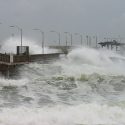Lake districts serve as prisms of environmental change
Two vastly different Wisconsin lake districts – one in a dynamic agricultural and urban setting, the other in a forested and much less developed region of the state – are proving their value as sentinels of regional environmental change, according to a new report.
Writing in the April issue of the journal BioScience, an interdisciplinary team of Wisconsin researchers shows that dramatic ecological change is occurring at the regional level, driven by a host of pressures ranging from urban and agricultural runoff to the loss of habitats and the introduction of exotic species.
"Both of these districts are changing really fast, but they're changing in different ways," notes Stephen R. Carpenter, a University of Wisconsin–Madison limnologist and the lead author of the new BioScience report.
The most dramatic change is occurring in the lake district around Madison, a region characterized by the urban influence of the state's capitol city, and booming suburban development and agriculture. In particular, biogeochemical and hydrological changes – driven by urban, suburban and agricultural runoff and nutrients from fertilizers – are occurring at an unprecedented magnitude and manifest themselves in the greatly accelerated eutrophication processes in the lakes of the region.
"Lake Mendota is the poster child of lake eutrophication," says Carpenter, "and eutrophication is probably the most widespread water-quality problem in the world, and Lake Mendota is one of the best-studied cases."
Changes to the other lake district, the Northern Highland Lake District, for the most part in Vilas County and constituting one of the greatest concentrations of freshwater lakes in the world, are mostly biological, according to the new report.
"We do find that biotic change is happening in both districts, and we think that's the canary in the coal mine. But the very large biogeochemical and hydrological changes we see are only happening in the Yahara Lakes District," says Carpenter, referring to the chain of lakes in southern Wisconsin linked by the Yahara River.
The two lake districts differ in significant respects, but the common denominator driving ecological change is pervasive human influence.
"Different trends in the lakes follow from differences in the way people changed the landscapes," says Carpenter, a lake expert who led the interdisciplinary team.
The lake districts make ideal environmental laboratories because ecological change tends to be reflected in the biological communities and chemical makeup of the lakes. With different kinds of development and human pressures in play, the districts are changing in markedly different ways.
Up north, the first and most noticeable changes involve the plants and animals that live in a lake. Introduced species such as the rusty crayfish and rainbow smelt have displaced plants and animals native to the lakes, affecting fishing and water quality and disrupting the food webs that are the basis for life in the lakes. "We are watching closely to see if biological changes make the northern lakes more vulnerable to future stresses as climate change intensifies," notes Carpenter.
In the south, the story is about runoff and the chemicals that flow into the lakes from farm fields, suburban lawns and city streets, says Carpenter. "Everything runs down hill, and the lake tells us about it. We're seeing more runoff and more variability in runoff. The watershed is getting flashier. It is more susceptible to pulses of water."
Those pulses of water come about as land is cleared for development and impermeable surfaces such as roads, parking lots and driveways cover ever more ground in the watershed for the Yahara River Lake District. The upshot, says Carpenter, will be an increase in flooding, a phenomenon he has observed firsthand as the basement of the lakeside lab where he works has been flooded three times in the past 15 years.
"Three times in the past 15 years means these are not rare events anymore, and there is more potential for floods in the Yahara River Lake District."
Both lake districts are a part of the National Science Foundation-supported network of Long-Term Ecological Research projects and will be increasingly important as barometers of environmental change in years to come.
Monitoring the lake districts and human influence on them by interdisciplinary teams of natural and social scientists is likely to give us our best window to environmental change and the human pressures propelling it, Carpenter argues.



